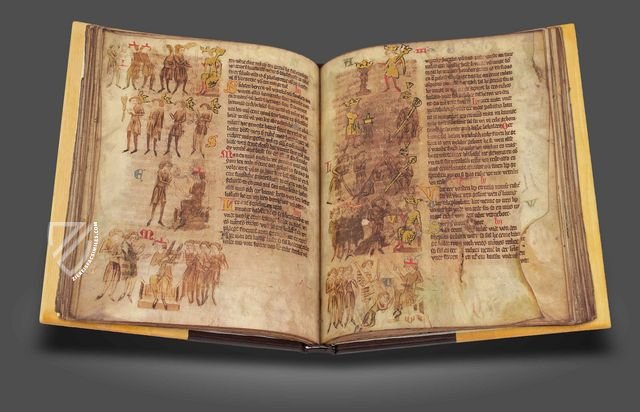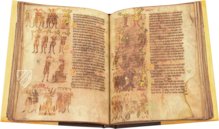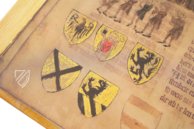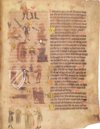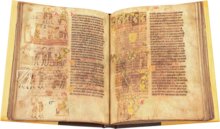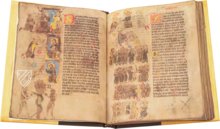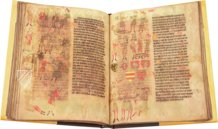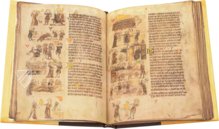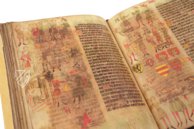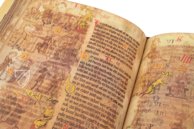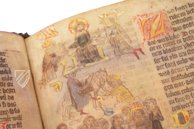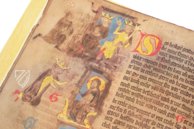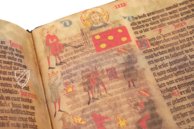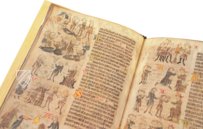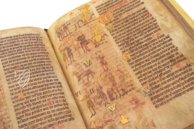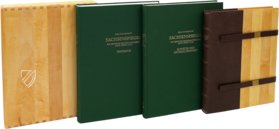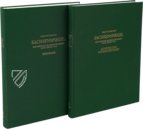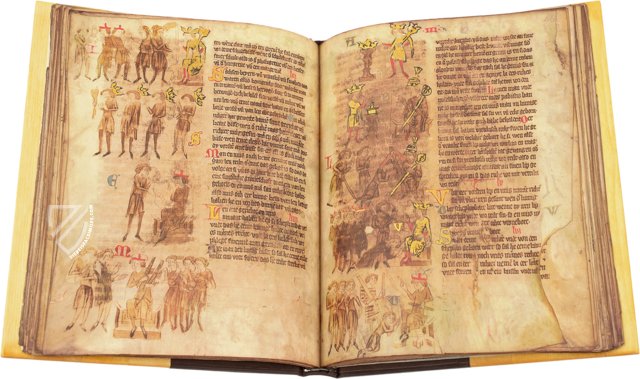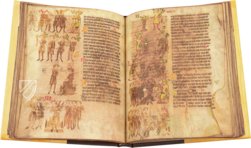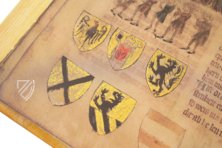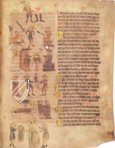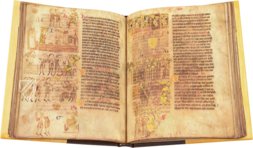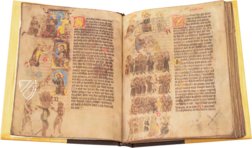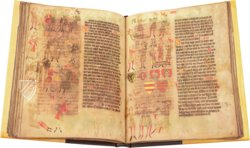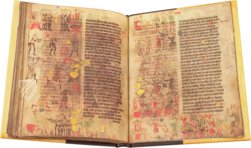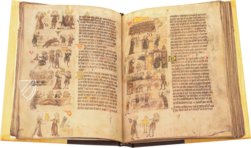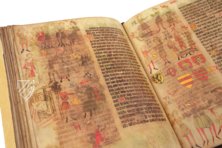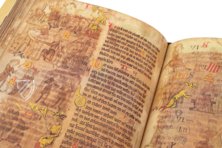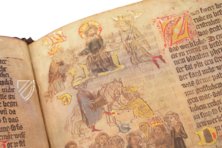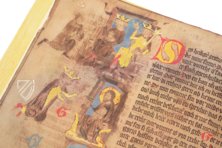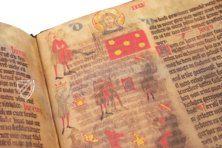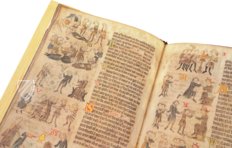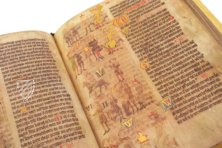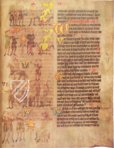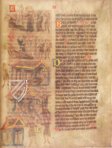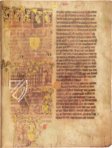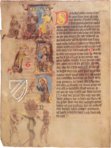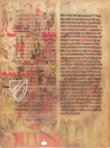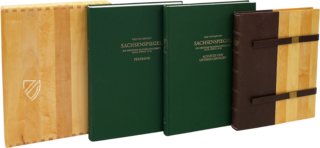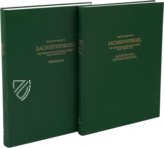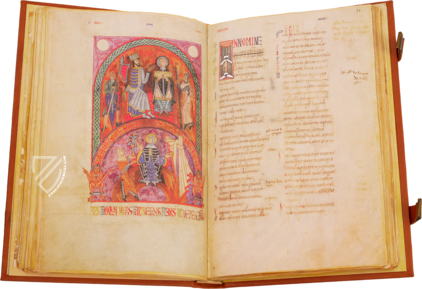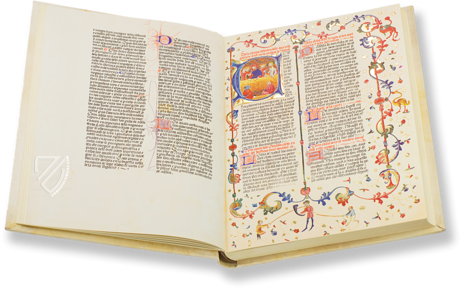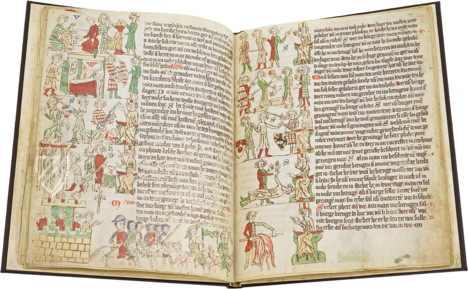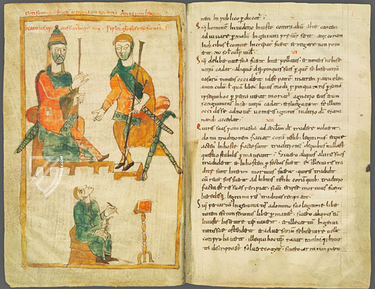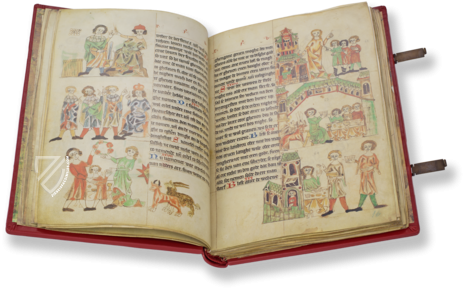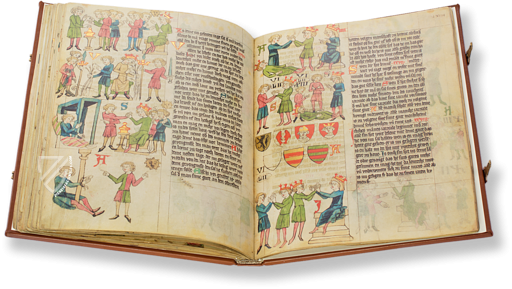Dresden Mirror of Saxony
(1,000€ - 3,000€)
Born ca. 1180 near Dessau, Eike von Repgow was a witness at the imperial court and advisor to several rulers. In the face of their power struggles, particularly between the Guelf and Hohenstaufen dynasties, and before the background of the German colonization in the regions east of the rivers Elbe and Saale, he strived to create a secure legal situation. Between 1220 and 1235, he thus decided to lay down the customary law used by the courts of justice. Among the hundreds of specimens to survive, the Dresden Mirror of Saxony is undoubtedly the most richly illuminated. Presumably made between 1347 and 1363, probably in Meissen, it features, opposite the text pages on the right, 924 picture strips, between four and eight per page, explaining the text of the Mirror of Saxony. It is not only a unique work of art, but also reflects the culture of the German Middle Ages making it an irreplaceable source for historians specializing in medieval civilization.
Dresden Mirror of Saxony
The Mirror of Saxony is the most important compilation of legal texts of the German Middle Ages. Named after its repository, the most sumptuous manuscript of this genre, richly decorated with gold and illuminated with a sheer unbelievable wealth of illustrations, is without a doubt the Dresden Mirror of Saxony.
924 Fantastic Picture Strips of Medieval German Law
With its 924 picture strips on 92 leaves (format 33 x 26 cm), which illustrate the basics of the German legal system in the Middle Ages in astounding multitude, the Dresden Mirror of Saxony not only constitutes a unique work of art, but also reflects the culture of the German Middle Ages: no less than 4,000 different persons appear; domestic utensils, tools, vestments and articles of daily use make the Dresden Mirror of Saxonyan irreplaceable source for historians specializing in medieval civilization.
A Truly Royal Work: Gold on Every Single Page
Unfortunately, the artists who participated in the decoration of the work are unknown, but they must have been the best of their time, as all miniatures of the manuscript were executed with the highest perfection and enormous love of detail. Most fascinating is the sheer exuberance of the manuscript’s decoration: each page of the Dresden Mirror of Saxony is richly heightened with gold.
Illustrations and German Text in Perfect Harmony
Opposite the text pages on the right, the 924 picture strips, between four and eight per page, explain the text of the Mirror of Saxony. Countless decorative initials, uppercase letters, and majuscules divide the columns. In addition, the picture strips are linked to the German text through golden and colorful capital letters.
Margrave Frederick of Meissen – the Patron?
The Dresden Mirror of Saxony was presumably made between 1347 and 1363, probably in Meissen. At this time, the residence of the margraves of Meissen was the center of Upper Saxony. Among the main concerns of Margrave Frederick III (1349–1381) were the improvement of the administration and the codification of customary law.
The Legal Work of Eike von Repgow
Born ca. 1180 near Dessau, Eike von Repgow was a witness at the imperial court and advisor to several rulers. In the face of their power struggles, particularly between the Guelf and Hohenstaufen dynasties, and before the background of the German colonization in the regions east of the rivers Elbe and Saale, he strived to create a secure legal situation. Between 1220 and 1235, he thus decided to lay down the customary law used by the courts of justice. Eike von Repgow’s text, known as the Mirror of Saxony, enjoyed widespread use: more than 400 manuscripts or fragments survive and bear testimony to the great importance of this text. It informs us about the legal status of nearly all groups of persons and classes of society: of sovereigns and knights, of peasants and the clergy.
"Landrecht" and "Lehnrecht"
The Mirror of Saxony is divided into two parts: "Landrecht", territorial law, and "Lehnrecht", feudal law. The prologue speaks of the close relationship between God and mankind and warns all human beings to respect these laws that allegedly were decreed by the Roman Emperor Constantine (307–377) and Charlemagne (768–814). "Landrecht" comprises all domains having to do with the possession of land, the right of succession, and legal statutes regarding marriage; it additionally contains the penal and constitutional law, i.e. criminal and civil law and procedure. The feudal law describes the hierarchic order of the Middle Ages, from the order of military shields to the feudal jurisdiction.
Standards of Sanitation and Traffic Laws
The down-to-earth character of the Mirror of Saxony certainly contributed to its widespread use. Several aspects of it are still in force today or have provided the basis for current legal standards. One major aspect was the regulation concerning life in the rural communities. The narrow roads in the villages required the right of way in case two carts met at a cross-roads. As a lightweight vehicle has less difficulty to make way, it was provided that empty carts would have to give way to loaded ones, such as pedestrians to persons on horseback. Other regulations provide for the safe distance to be kept from the oven as well as for the distance from lavatories and pigsties to avoid odor, thus proving a certain awareness in the interest of the community health.
The Illuminated Manuscripts of the Mirror of Saxony
Among the 400 surviving copies of the Mirror of Saxony, four illuminated luxury manuscripts stand out in particular: our Dresden codex – artistically speaking the most precious and most richly illuminated of all – as well as the Heidelberg Mirror of Saxony (ca. 1300) containing 310 picture strips, the Wolfenbüttel Mirror of Saxony (around 1365) with 776 picture strips and the Oldenburg Mirror of Saxony (1336) with its 578 picture strips. The latter was also reproduced years ago by ADEVA and the edition was sold out soon after publication.
The Fine Art Facsimile Edition
In order to preserve the precious, recently restored manuscript, Akademische Druck- u. Verlagsanstalt Graz were charged with the reproduction of this unique work of art by the Saxon State Library – Staats- und Universitätsbibliothek Dresden. All 92 leaves with their 924 picture strips in the original format of 33 x 26 cm have been reproduced down to the minutest detail in proven quality. An impressive feature is the reproduction of gold to be found on every single page of the manuscript. Each leaf has been trimmed in accordance with the original. Up-to-date electronic processes paired with the traditional, centuries-old art of bookbinding guarantee perfect results. The quires have been assembled, stitched and attached to five raised bands. The binding, a faithful reproduction of the current original binding, consists of a noble wooden board half-covered with genuine leather. The case is made of the same wood as the cover of the facsimile volume, completing the exquisite appointment of the edition.
Codicology
- Alternative Titles
- Dresdner Sachsenspiegel
- Size / Format
- 184 pages / 33.0 × 26.0 cm
- Origin
- Germany
- Date
- Between 1347 and 1363
- Epochs
- Style
- Language
- Illustrations
- 924 picture strips (between four and eight per page) showing no less than 4,000 different persons, domestic utensils, tools, vestments and articles of daily use
- Content
- The most important compilation of medieval German legal texts
- Patron
- Frederick III, Margrave Meissen (1349–1381)
- Artist / School
- Eike von Repgow (author)
Dresden Mirror of Saxony
The Pope and Kaiser as Judges
This section from the third book on customary law establishes that the Holy Roman Emperor, dressed in cloth of gold with crown and scepter, and the Pope, wearing the papal tiara and holding a golden staff, share jurisdiction and collaborate as the highest judges of secular and ecclesiastical affairs. Above, God’s anointed judges are depicted gesturing at one another, presumably debating a trial in private, while below, they are seated together on the same bench with their arms around each other’s shoulders, presenting a united, even amicable public image.
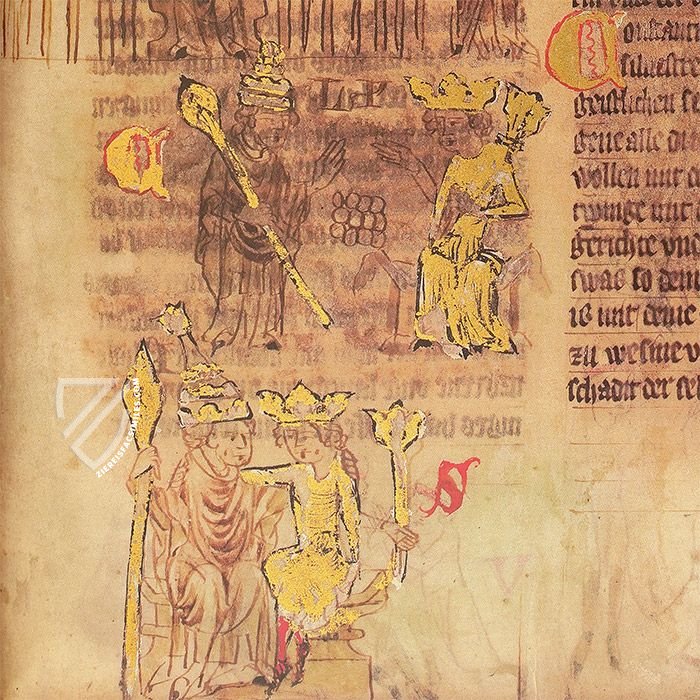
Dresden Mirror of Saxony
Prologue
The text of the Mirror of Saxony begins by establishing man’s law as subordinate to and based upon God’s law with the Kaiser serving as a divine regent. As such, Adam and Eve are depicted at the bottom of the page partaking of the forbidden fruit – the first violation of God’s law. The serpent is given a golden crown in reference to the Lucifer’s former status as the highest of the angels – a prince of heaven – before his rebellion and expulsion from Heaven.
At the top of the page, the author, Eike von Repgow, kneels before Constantine, the first Christian emperor of the Romans, and Charlemagne, who reestablished most of the Western Roman Empire. It is not clear who is holding the globus cruciger and who is holding the scepter, but the latter figure, dressed in cloth of gold, pays homage in the manner of a feudal vassal to Christ, who holds a sword – symbol of martial authority – and a book – symbol of legal authority. Adam is the nude figure kneeling before Christ and receives His blessing and forgiveness for his sins.
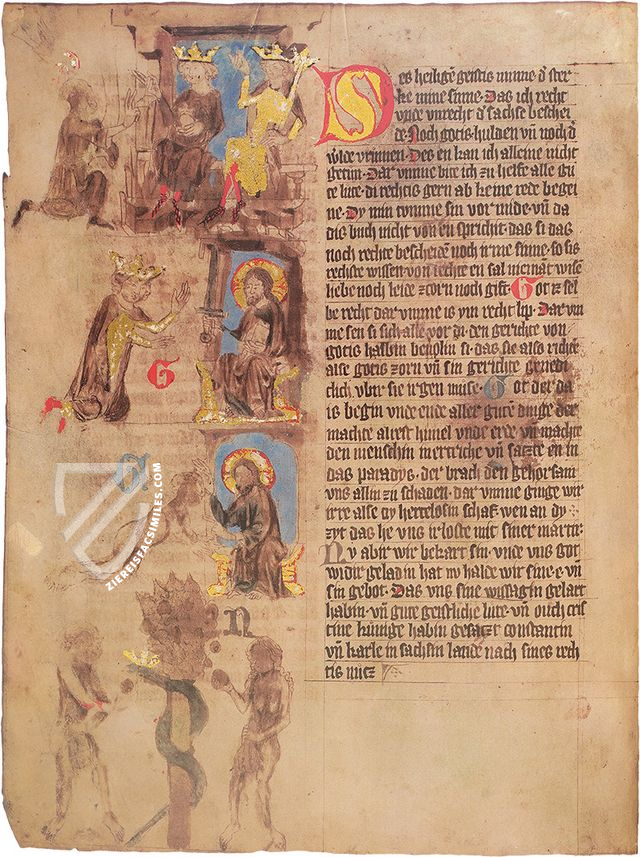
#1 Der Dresdner Sachsenspiegel
Language: German
Ed. by Heiner Lück. The commentary comprises two volumes:
1) A commentary volume containing a comprehensive description of the manuscript and all illustrations.
2) A text volume containing a transcription and translation of the text into modern German.
Both commentary volumes are bound in cloth.
(1,000€ - 3,000€)
- Treatises / Secular Books
- Apocalypses / Beatus
- Astronomy / Astrology
- Bestiaries
- Bibles / Gospels
- Chronicles / History / Law
- Geography / Maps
- Saints' Lives
- Islam / Oriental
- Judaism / Hebrew
- Single Leaf Collections
- Leonardo da Vinci
- Literature / Poetry
- Liturgical Manuscripts
- Medicine / Botany / Alchemy
- Music
- Mythology / Prophecies
- Psalters
- Other Religious Books
- Games / Hunting
- Private Devotion Books
- Other Genres
- Afghanistan
- Armenia
- Austria
- Belgium
- Belize
- Bosnia and Herzegovina
- China
- Colombia
- Costa Rica
- Croatia
- Cyprus
- Czech Republic
- Denmark
- Egypt
- El Salvador
- Ethiopia
- France
- Germany
- Greece
- Guatemala
- Honduras
- Hungary
- India
- Iran
- Iraq
- Israel
- Italy
- Japan
- Jordan
- Kazakhstan
- Kyrgyzstan
- Lebanon
- Liechtenstein
- Luxembourg
- Mexico
- Morocco
- Netherlands
- Palestine
- Panama
- Peru
- Poland
- Portugal
- Romania
- Russia
- Serbia
- Spain
- Sri Lanka
- Sweden
- Switzerland
- Syria
- Tajikistan
- Turkey
- Turkmenistan
- Ukraine
- United Kingdom
- United States
- Uzbekistan
- Vatican City
- A. Oosthoek, van Holkema & Warendorf
- Aboca Museum
- Ajuntament de Valencia
- Akademie Verlag
- Akademische Druck- u. Verlagsanstalt (ADEVA)
- Aldo Ausilio Editore - Bottega d’Erasmo
- Alecto Historical Editions
- Alkuin Verlag
- Almqvist & Wiksell
- Amilcare Pizzi
- Andreas & Andreas Verlagsbuchhandlung
- Archa 90
- Archiv Verlag
- Archivi Edizioni
- Arnold Verlag
- ARS
- Ars Magna
- ArtCodex
- AyN Ediciones
- Azimuth Editions
- Badenia Verlag
- Bärenreiter-Verlag
- Belser Verlag
- Belser Verlag / WK Wertkontor
- Benziger Verlag
- Bernardinum Wydawnictwo
- BiblioGemma
- Biblioteca Apostolica Vaticana (Vaticanstadt, Vaticanstadt)
- Bibliotheca Palatina Faksimile Verlag
- Bibliotheca Rara
- Boydell & Brewer
- Bramante Edizioni
- Bredius Genootschap
- Brepols Publishers
- British Library
- C. Weckesser
- Caixa Catalunya
- Canesi
- CAPSA, Ars Scriptoria
- Caratzas Brothers, Publishers
- Carus Verlag
- Casamassima Libri
- Centrum Cartographie Verlag GmbH
- Chavane Verlag
- Christian Brandstätter Verlag
- Circulo Cientifico
- Club Bibliófilo Versol
- Club du Livre
- CM Editores
- Collegium Graphicum
- Collezione Apocrifa Da Vinci
- Comissão Nacional para as Comemorações dos Descobrimentos Portugueses
- Coron Verlag
- Corvina
- CTHS
- D. S. Brewer
- Damon
- De Agostini/UTET
- De Nederlandsche Boekhandel
- De Schutter
- Deuschle & Stemmle
- Deutscher Verlag für Kunstwissenschaft
- DIAMM
- Droz
- E. Schreiber Graphische Kunstanstalten
- Ediciones Boreal
- Ediciones Grial
- Ediclube
- Edições Inapa
- Edilan
- Editalia
- Edition Deuschle
- Edition Georg Popp
- Edition Leipzig
- Edition Libri Illustri
- Editiones Reales Sitios S. L.
- Éditions de l'Oiseau Lyre
- Editions Medicina Rara
- Editorial Casariego
- Editorial Mintzoa
- Editrice Antenore
- Editrice Velar
- Edizioni Edison
- Egeria, S.L.
- Eikon Editores
- Electa
- Emery Walker Limited
- Enciclopèdia Catalana
- Eos-Verlag
- Ephesus Publishing
- Ernst Battenberg
- Eugrammia Press
- Extraordinary Editions
- Fackelverlag
- Facsimila Art & Edition
- Facsimile Editions Ltd.
- Facsimilia Art & Edition Ebert KG
- Faksimile Verlag
- Feuermann Verlag
- Folger Shakespeare Library
- Franco Cosimo Panini Editore
- Friedrich Wittig Verlag
- Fundación Hullera Vasco-Leonesa
- G. Braziller
- Gabriele Mazzotta Editore
- Gebr. Mann Verlag
- Gesellschaft für graphische Industrie
- Getty Research Institute
- Giovanni Domenico de Rossi
- Giunti Editore
- Graffiti
- Grafica European Center of Fine Arts
- Guido Pressler
- Guillermo Blazquez
- Gustav Kiepenheuer
- H. N. Abrams
- Harrassowitz
- Harvard University Press
- Helikon
- Hendrickson Publishers
- Henning Oppermann
- Herder Verlag
- Hes & De Graaf Publishers
- Hoepli
- Holbein-Verlag
- Houghton Library
- Hugo Schmidt Verlag
- Idion Verlag
- Il Bulino, edizioni d'arte
- ILte
- Imago
- Insel Verlag
- Insel-Verlag Anton Kippenberger
- Instituto de Estudios Altoaragoneses
- Instituto Nacional de Antropología e Historia
- Introligatornia Budnik Jerzy
- Istituto dell'Enciclopedia Italiana - Treccani
- Istituto Ellenico di Studi Bizantini e Postbizantini
- Istituto Geografico De Agostini
- Istituto Poligrafico e Zecca dello Stato
- Italarte Art Establishments
- Jan Thorbecke Verlag
- Johnson Reprint Corporation
- Josef Stocker
- Josef Stocker-Schmid
- Jugoslavija
- Karl W. Hiersemann
- Kasper Straube
- Kaydeda Ediciones
- Kindler Verlag / Coron Verlag
- Kodansha International Ltd.
- Konrad Kölbl Verlag
- Kurt Wolff Verlag
- La Liberia dello Stato
- La Linea Editrice
- La Meta Editore
- Lambert Schneider
- Landeskreditbank Baden-Württemberg
- Leo S. Olschki
- Les Incunables
- Liber Artis
- Library of Congress
- Libreria Musicale Italiana
- Lichtdruck
- Lito Immagine Editore
- Lumen Artis
- Lund Humphries
- M. Moleiro Editor
- Maison des Sciences de l'homme et de la société de Poitiers
- Manuscriptum
- Martinus Nijhoff
- Maruzen-Yushodo Co. Ltd.
- MASA
- Massada Publishers
- McGraw-Hill
- Metropolitan Museum of Art
- Militos
- Millennium Liber
- Müller & Schindler
- Nahar - Stavit
- Nahar and Steimatzky
- National Library of Wales
- Neri Pozza
- Nova Charta
- Oceanum Verlag
- Odeon
- Orbis Mediaevalis
- Orbis Pictus
- Österreichische Staatsdruckerei
- Oxford University Press
- Pageant Books
- Parzellers Buchverlag
- Patrimonio Ediciones
- Pattloch Verlag
- PIAF
- Pieper Verlag
- Plon-Nourrit et cie
- Poligrafiche Bolis
- Presses Universitaires de Strasbourg
- Prestel Verlag
- Princeton University Press
- Prisma Verlag
- Priuli & Verlucca, editori
- Pro Sport Verlag
- Propyläen Verlag
- Pytheas Books
- Quaternio Verlag Luzern
- Reales Sitios
- Recht-Verlag
- Reichert Verlag
- Reichsdruckerei
- Reprint Verlag
- Riehn & Reusch
- Roberto Vattori Editore
- Rosenkilde and Bagger
- Roxburghe Club
- Salerno Editrice
- Saltellus Press
- Sandoz
- Sarajevo Svjetlost
- Schöck ArtPrint Kft.
- Schulsinger Brothers
- Scolar Press
- Scrinium
- Scripta Maneant
- Scriptorium
- Shazar
- Siloé, arte y bibliofilia
- SISMEL - Edizioni del Galluzzo
- Sociedad Mexicana de Antropología
- Société des Bibliophiles & Iconophiles de Belgique
- Soncin Publishing
- Sorli Ediciones
- Stainer and Bell
- Studer
- Styria Verlag
- Sumptibus Pragopress
- Szegedi Tudomànyegyetem
- Taberna Libraria
- Tarshish Books
- Taschen
- Tempus Libri
- Testimonio Compañía Editorial
- Thames and Hudson
- The Clear Vue Publishing Partnership Limited
- The Facsimile Codex
- The Folio Society
- The Marquess of Normanby
- The Richard III and Yorkist History Trust
- Tip.Le.Co
- TouchArt
- TREC Publishing House
- TRI Publishing Co.
- Trident Editore
- Tuliba Collection
- Typis Regiae Officinae Polygraphicae
- Union Verlag Berlin
- Universidad de Granada
- University of California Press
- University of Chicago Press
- Urs Graf
- Vallecchi
- Van Wijnen
- VCH, Acta Humaniora
- VDI Verlag
- VEB Deutscher Verlag für Musik
- Verlag Anton Pustet / Andreas Verlag
- Verlag Bibliophile Drucke Josef Stocker
- Verlag der Münchner Drucke
- Verlag für Regionalgeschichte
- Verlag Styria
- Vicent Garcia Editores
- W. Turnowski Ltd.
- W. Turnowsky
- Waanders Printers
- Wiener Mechitharisten-Congregation (Wien, Österreich)
- Wissenschaftliche Buchgesellschaft
- Wissenschaftliche Verlagsgesellschaft
- Wydawnictwo Dolnoslaskie
- Xuntanza Editorial
- Zakład Narodowy
- Zollikofer AG

